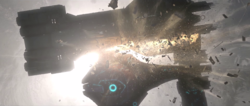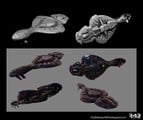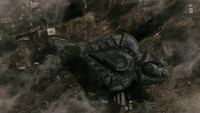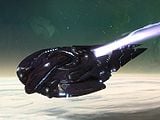Nanolaminate
From Halopedia, the Halo wiki

Nanolaminate hull plating is the most common form of battle plating found on the Covenant's warships.[1] It is typically purplish in color, although the CAS-class assault carrier has a pale white-blue hull and Kig-Yar vessels are generally bluish-black in color.[2] Nanolaminate plating was noted for causing the hulls of Covenant vessels to possess an odd, opalescent-like shine.[3] The plating is very strong and heat resistant, with the support of energy shielding allowing Covenant ships to take more damage.[4] The amount of nanolaminate plating applied to each ship depends on the class, though CSO-class supercarriers have well over thirty meters of armor plating.[5] As of 2525, nanolaminate plating is not used in any human construction.[6]
It is likely that Covenant dropships, such as the Type-52 Phantom, or assault platforms, such as the Type-47 Scarab, are covered with nanolaminate hull plating.
Characteristics
Defensive capabilities
The hull plating allows ships to be resilient to most UNSC weaponry. UNSC point-defense guns are not powerful enough to do significant damage to the plating,[7] Archer missiles prove to be very effective against the unshielded hull of a Covenant vessel causing the ship to become very vulnerable following the resulting explosions of the missiles.[8] Magnetic Accelerator Cannons are often used to disable and destroy Covenant vessels after the energy shielding fails, being powerful enough to pierce the nanolaminate hull plating of most ships with a single round.[9] A single pack of C-12 shaped charges can easily puncture a large hole through the hull of a Covenant cruiser.[10] A Covenant cruiser is capable of taking a direct hit from a mass driver at near point-blank range with only minor structural damage done to the nanolaminate plating, but a second hit in the same spot was capable of piercing the vessel.[11]
However, Covenant weaponry is more effective against nanolaminate plating. The CSO-class supercarrier Ascendant Justice, one of the most powerful vessels in the Covenant fleet, was heavily damaged by a single plasma turret torpedo, with several layers of the armor plating boiling away.[12]
The nanolaminate plating is also durable against direct collisions with other vessels. A CPV-class heavy destroyer took negligible damages after a direct collision with the UNSC Spirit of Fire, with its energy shields seemingly not active.[13] Although during the Second Battle of Requiem, a RCS-class armored cruiser equipped with energy shields, one of the former Covenant's most armored vessels, was obliterated after it endured a collision with the UNSC Infinity, with seemingly no damage done to the Infinity.[14]
Heat resilience
The nanolaminate plating is very heat resistant, allowing Covenant vessels to enter extreme atmospheres or absorb the long-range damage from human nuclear weapons. Upon entering the gas giant Threshold's atmosphere shield-less, the hull of Ascendant Justice heated to three hundred degrees Celsius, with no actual structural damage done to the ship.[4] Only when the ship reached temperatures of over seventeen hundred degrees Celsius did minor hull tearing and conduit melting occur.[15] However, at such high temperatures, the superstructure of the vessel becomes considerably softened.[16]
Trivia
The shield used by the Covenant's Mgalekgolo soldiers appears to be made up of a similar alloy.
Gallery
- Reach - Supercarrier.png
A render of a CSO-class supercarrier, armored with over 30 meters of nanolaminate plating.
Covenant space fighters, like the Seraph, were armored with nanolaminate plating.
Sources
- ^ Halo Waypoint: Catalog Interaction - Page 14
- ^ Halo: Contact Harvest, page 26
- ^ Halo: The Fall of Reach, page 119
- ^ a b Halo: First Strike, page 79
- ^ Halo: First Strike, page 266
- ^ Halo: Contact Harvest, page 176
- ^ Halo: The Fall of Reach, page 272
- ^ Halo: The Fall of Reach, page 179
- ^ Halo: The Fall of Reach, page 297
- ^ Halo: Evolutions - Essential Tales of the Halo Universe, "Blunt Instruments", page 202
- ^ Halo: Contact Harvest, page 342
- ^ Halo: First Strike, page 76
- ^ Halo Wars, campaign level, Repairs
- ^ Halo 4, Departure
- ^ Halo: First Strike, page 84
- ^ Halo: First Strike, page 223




